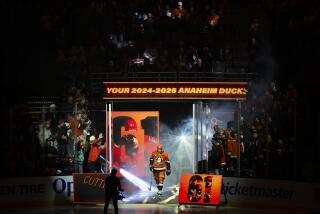Keeping top line in check is priority
- Share via
The most prolific scoring trio of the Stanley Cup playoffs skates for the Ottawa Senators: center Jason Spezza, right wing Daniel Alfredsson and left wing Dany Heatley. In 15 postseason games, they have combined for 23 goals and 58 points to give the Senators a dominating No. 1 line.
After ripping through the checking lines of the Pittsburgh Penguins, New Jersey Devils and Buffalo Sabres, Ottawa’s big three now will be matched up against the Ducks’ best defensive forwards: Samuel Pahlsson, Travis Moen and Rob Niedermayer.
Over the first two rounds of the playoffs, the Ducks’ checkers effectively put the clamps on Minnesota’s Marion Gaborik and Pavol Demitra, and Vancouver’s Sedin twins, Daniel and Henrik.
Then in the Western Conference finals, Detroit Coach Mike Babcock split up his top line that included Henrik Zetterberg and Pavel Datsyuk so as to prevent Pahlsson and Co. from keying on one line. It almost worked.
Many factors will determine this year’s Stanley Cup champion, and one of the most important will be the Spezza vs. Pahlsson line matchup. Here’s a quick breakdown:
Familiarity: During the NHL lockout season, Pahlsson and Alfredsson were linemates and led Vastra Frolunda to the Swedish Elite league championship in 2005. The next year, they were Olympic teammates on Sweden’s gold-medal team. Let’s just say that they know each other well.
But Pahlsson’s main assignment will be keeping Spezza under wraps and that will be extremely difficult. As one of hockey’s best pass-first centermen, Spezza creates scoring opportunities in spaces most players would never think of and that will be Pahlsson’s biggest challenge. At 6 feet 2 and 205 pounds, Spezza has a slight edge in size, but Pahlsson (6-0, 210) is a lot stronger than some might think.
The key will be whether Pahlsson can stay close enough to frustrate Spezza over the course of a best-of-seven series.
Strategy: If the Ducks allow one of the Senators’ dynamic three to enter the attacking zone with speed, they will be in trouble. No team has mastered the “new” NHL better than Ottawa, which has made a habit of turning defensive stops into transition breakaways during the postseason.
Look for the Ducks to attempt to lock down any middle ice passes made by the Senators, especially between the blue lines. Just think back to Alfredsson’s overtime goal against Buffalo that ended the Eastern Conference finals. For Ducks Coach Randy Carlyle, the more he sees dump-and-chase with the Spezza line, the better.
Although Ottawa relies heavily on the Spezza line, the Senators feature four balanced lines with 10 forwards averaging more than 10 minutes of ice time a game. This could be a problem for the Ducks, who enter the finals with eight available forwards averaging double digits in minutes.
Thanks to the aid of additional television timeouts in the playoffs, Carlyle has been able to rely on three lines, but the Senators’ overall depth may force him to give his fourth line more time. If that happens, that may open up opportunities for Spezza’s line to face someone other than Pahlsson and Co.
Summary: Although the Ducks’ checkers will be called on to match up against Spezza’s line, Carlyle’s main security blanket will be defensemen Scott Niedermayer, Chris Pronger and Francois Beauchemin. If the Senators’ top line does break free, it will be important for these three blue liners not to be intimidated by the speed of Spezza, Alfredsson and Heatley and to make plays in front of goaltender Jean-Sebastien Giguere.
More to Read
Go beyond the scoreboard
Get the latest on L.A.'s teams in the daily Sports Report newsletter.
You may occasionally receive promotional content from the Los Angeles Times.






